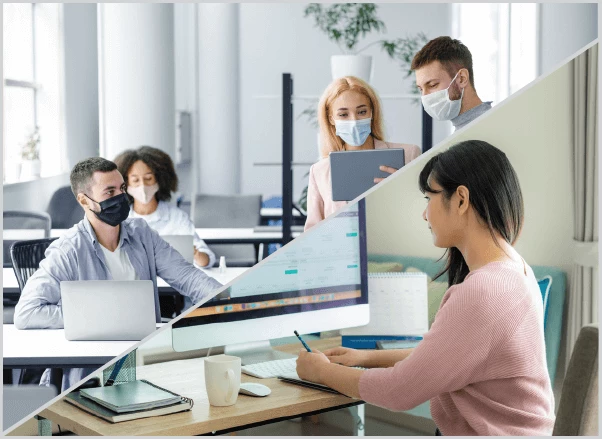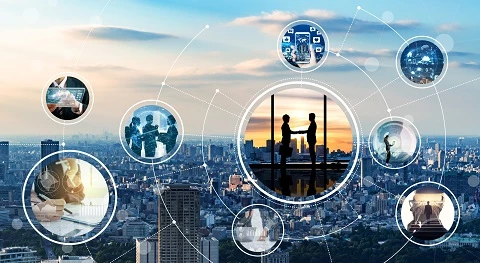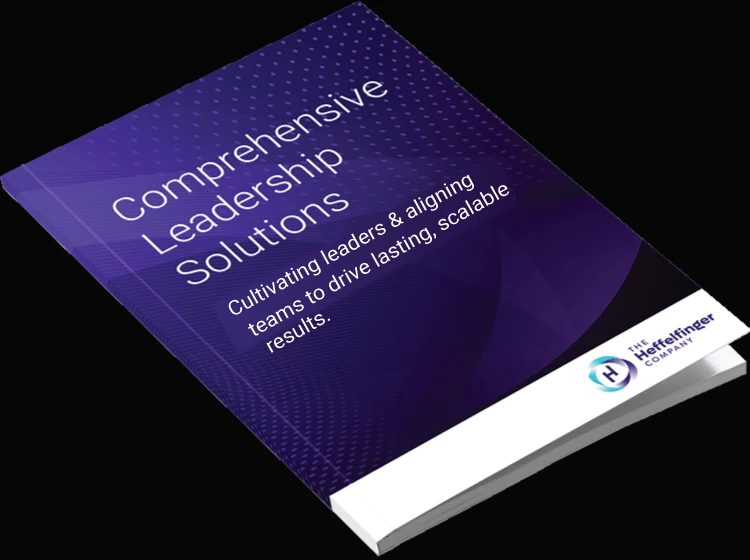No sensible decision can be made any longer without taking into account not only the world as it is, but the world as it will be. ~ Isaac Asimov
Determining if the Hybrid Workplace is Right for You
At our recent webinar on Adaptive Leadership, one of our participants – said we keep waiting for the experts to come out with information regarding what direction we should be taking, but there isn’t anything forthcoming. Others in the webinar said, “what is working for them is not creating fixed plans or getting locked into any of their plans,” as things keep changing (pandemic numbers, vaccination numbers, employee preferences, and challenges, market conditions, etc.)
In the past, it seemed, we were able to look to someone else for the answers. Someone else had already done it or had written about what and how to do it. Now, the answer is unique to each organization and industry.
As we were researching for this blog, we found many recent survey results that identify what CEOs see as risks and opportunities, what they are focused on, and what they have learned. However, the direction and decisions that you and your organization should take are variable and depend on many factors related to your organization and your industry. We will share some of the information from the surveys in this blog. The decisions remain yours.
We advise you to keep these three points in mind as you are planning: Complexity, Intentionality, and Flexibility. Complexity is here to stay. Organizations need to think and act intentionally by planning but not rigidly sticking with their plans – remain flexible and adaptable. We’ll get into each of these points in more detail.
We are sure some of you are saying. “I’m tired of complexity and being flexible. I want some simple answers and some firmness in planning.” If we take a breath and realize we are still alive after all we have been through in the last year and see the possibility of Leaning in, Accepting, Letting Go, and Embracing – we will come out of this far better than before the pandemic. Possible? Yes! Hard to believe? Maybe. But definitely possible!
Complexity
Complexity will continue as we ease out of Pandemic restrictions and deal with their aftermath and what lies ahead that we have yet to experience.
Per a 2021 Conference Board Survey, CEOs see the following legacies:
Many would say these are the great legacies COVID has left us, and yet they add complexity.
- Reduced business travel means we must figure out how to build client and colleague relationships differently. We must manage multiple time zones. Many of our clients work late into the evening to meet with teams globally.
- More automated tasks bring with them the need to learn new technologies, new apps. They also carry the task of figuring out how they do or do not integrate.
Our new Executive Assistant has commented on our technology and wondering why we are using what we are using. It was great a year ago, and now, it needs to be updated. There is a learning curve to these things.
This increased automation most likely means our jobs will be different, and in some cases, they will be going away, or employees will no longer want to do them. Our colleagues in the Restaurant industry tell us that employees do not want to come back to their jobs given the big hit they took in the Pandemic.
- More resilient supply chains could mean that our shopping does not go back to in-person. So, what does that mean for retail storefronts and the shopping experience in general? We just purchased living room furniture online, and we have friends who bought cars and houses without seeing them in advance.
- Businesses are addressing social justice goals – many may see this as long overdue – but this is complex with polarized views about “right and wrong.” Sensitivities are heightened, and while we are more vigilant regarding diversity, inclusion, and equity – some may feel excluded in the process – and in some cases, this is heightening the divide and the conflict.
Hybrid Work involves a complex set of ever-changing decisions.
Per a 2020 Survey by GoodFirms Remote Work Preference – 70% of employees say they prefer working Hybrid post-COVID. Wired reported that the hybrid work model could create “two fundamentally different employee experiences.”
Some of our clients have told us when they are in hybrid meetings; the virtual participants have an advantage because they have their faces “on screen,” while those sitting in the conference room “in person” – may find it more difficult to contribute as easily. And, of course, it can work the other way as well – if there is a critical mass in person and others online.
Intentionality
Leaders and Organizations need to be intentional about thinking through all the possible consequences or variations of decisions they consider around Hybrid work. What is the culture the organization wants to have NOW – post Pandemic? What are the norms they want in the Hybrid World?
There is a lot of talk and worry about culture and organizations losing their culture in a Remote or Hybrid workplace. We see organizations not putting much thought into this. Some organizations are making quick decisions to bring their employees back to the office 3-5 days a week without discussing what this means to the employees.
And some of these decisions are being made with 30 days' notice or less, leaving HR, Facilities, and IT to deal with the logistics of office space, computers, internet service, HR policies, and potential legal liabilities around hybrid and virtual work.
Employees are making choices to work for employers they feel will take their personal preferences and considerations into account (i.e., childcare, working out of state, navigating preferences for commuting, travel, dress code, and working hours).
Some leaders feel they can only measure performance by seeing employees in person; some organizations still do not have good technology for remote or hybrid work. Not all leaders or employees can agree on the “right way” to do this.
Organizations need to put the thought into how Hybrid they can go. And what are the exceptions? Who gets to decide, Senior Leadership, Teams, Individuals? What are the various consequences of those decisions to Inclusion, Connection, Relationships, Collaboration? When must teams convene in person? What’s the best way to communicate virtually/hybrid? What’s the technology that will support those decisions?
And this is where Leadership and Employee Engagement come in.
The same 2021 Conference Board Survey mentioned earlier found that CEOs are clear about what is most needed NOW for leaders.
Yes, these qualities were all especially important BEFORE COVID-19 but now are even more critical. And we see the need for these qualities with our clients. We are getting more and more requests for Leader and Team Development and increasing concern about recruiting and retaining top talent. The need and concern intensity continue to increase.
We suggest putting your best foot forward with thoughtful planning and input, creating a “pilot” or experiment; something that can flex. Our recent Adaptive Leadership Webinar Attendees (CHROs and CIOs) highly endorse this idea of planning but not getting married to the plan. Yes, this may require a new attitude and mindset.
"I discovered I always have choices and sometimes it’s only a choice of attitude." ~ Judith M. Knowlton
We believe that many global organizations have been working with a Hybrid model all along because that is what it takes to work in global teams. With the increased interest in reduced business travel and commuting and increased automation, perhaps this isn’t so different after all. Perhaps the face-to-face working model was just a myth going back as far as the 1980s.
Before teleconferencing even existed, workers participated in global work teams. James reflects on his early work history when “we sat around speakerphones in the various offices around the world, with members occasionally calling in from hotel rooms or home. The teams had a goal with a defined result; the members were chosen based on their role or ability to get the work done. I worked from a home office in the '90s until I left the company at the turn of the century.”
What’s different today is that employers can now take the time to be intentional (and flexible) with increased technological capabilities. Employees need to develop new systems and processes for working, communicating, and making decisions.
Everyone in the organization will have to be intentional about defining and establishing new norms that will contribute to a great culture. All of this requires Leadership and Teaming. These are skills that to be learned with the support of good Trainers and Facilitators. We are here to help!
Flexibility
“The art of life lies in a constant readjustment to our surroundings.”
~ Kakuzō Okakura,” The Book of Tea”
A shift to a hybrid work model is a change available to companies worldwide and one for which they need to prepare a response. The change can be viewed as a positive, wholesale, fundamental shift in the way businesses operate, not merely an extension of a temporary work-from-home arrangement.
A flexible hybrid model can be attractive to both the company and employees. The organizations can save a fortune in real estate costs, and the employees can gain more control over their lives. It may not be perfect. There are some serious issues with which to contend. If companies bring back workers, there may be additional expenses incurred, potential legal liabilities concerning health risks to their employees. Another concern is the possible evolution of an emerging dual-class system, those who can work from home and those who cannot, for whatever reason, personal or organizational.
PwC found that 83% of employers say that the shift to remote work has been successful for their company. However, few executives believe that their company's cultures will survive a purely remote working setup. In fact, 29% feel that employees must be in the office at least three days a week to preserve their culture. And more than 4 out of 5 (21%) believe that the number of days is five. Only 5% believe that the employees never need to come to the office to maintain company culture.
Leaders and employees need to be both intentional AND flexible as these new Hybrid models are employed. The best approach is to be clear about the model's intention, i.e., Employee Experience, Well Being and Safety, Organizational Productivity, Collaboration, and Connection, whatever your organization decides as most important based on cultural and business objectives in the near term, mid-term, and long-term.
Having criteria for success (cultural values and norms) and the appropriate flexible structures to support those values and norms is essential. Focusing on the highest order success factors versus rigid structures is vital. Flexible systems (processes, policies, roles, reporting, etc.) that are easy to adapt over time are crucial.
Be willing to change and adapt as conditions change.
Summary
In summary, as you think about what your organization looks like going forward, whether it is Hybrid, all remote, or all in person, remember the following:
- Complexity – there are no simple tried and true answers, the answers you seek, lie in the art of teaming, engagement, and communication with your employees,
- Intentionality – be intentional about what you are doing and what you want to create, your new culture, ways of working, collaborating, deciding, connecting, communicating, delivering products and services,
- Flexibility – our ecosystems are constantly changing, know that all the planning, communicating, and engaging we do, will most likely result in the need to change again. Stay flexible, create conditions for success that allow for movement and adaption. Be ready to pivot.
We are here to help you through these times. We provide insight through our blogs and free webinars. We provide support through our Executive Coaching, Individual, Group, or Team. We help you achieve Senior Team Alignment to help you strategize, align, and execute. We offer Leadership programs, that help you build new leadership capabilities for the post-pandemic world.
If you would like more information on bringing Adaptive Leadership to your organization – please reach out to us atlorih@heffelfingerco.comorjames@heffelfingerco.com.
Let us know what other topics you are interested in hearing about as we consider topics for future blogs.
Warmly,
Lori and James
Lori Heffelfinger and James Jackman, MSOD
310-543-7632 office

Supporting Business Leaders to transform cultures and transition through the pandemic and beyond.
References:
- C-Suite Challenge 2021 Leading in A Post-Covid-19 Recovery by the Conference Board.
- Hybrid Remote Work Offers the Worst of Both Worlds by Sid Sijbrandij, Wired.
- It’s time to reimagine where and how work will get done, PwC’s US Remote Work Survey - January 12, 2021
- The Hybrid Work Model: Ready or Not Here It Comes by Traci Lounsbury and Denny Sponsel, Work Design Magazine.
- The ‘Hybrid Model’ Of Working Remotely and In the Office Could Create Big Expenses For Companies And Give Rise To Two Classes Of Employees, by Jack Kelly, Senior Contributor, Forbes.







